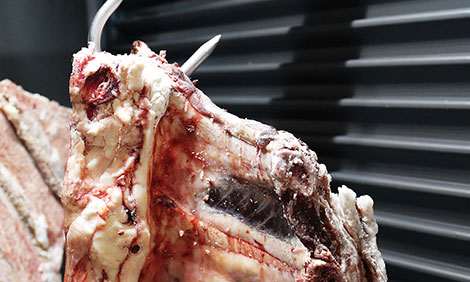
In order to make it really enjoyable, freshly slaughtered beef must “hang and mature” at cool temperatures. The effect of the centuries-old butcher tradition has long been proved by chemical knowledge. In the case of meat, not only does a delicate consistency but also the taste develop. Fresh meat is actually inedible.
Immediately after slaughter, biochemical processes are released in the meat. The lack of oxygen leads to anaerobic glycolysis, in which glycogen and glucose are degraded. This reduces the pH to about 5.6. When the glucose stores are exhausted and no adenosine triphosphate (ATP) can be formed, the muscles become firm. This leads to a muscular contraction, the Rigor Mortis, which in the so called dead or corpse stars. The muscle flesh hardens by the low water binding. If the meat were prepared at this stage, a tough to leathery cloth with little taste would remain. Only then do the enzymatic processes begin, which make the meat again delicate and thus edible.

Meat mainly consists of water, proteins and fat. They are rather neutral. In the case of meat, however, further substances are produced which act as flavor carriers. For example, proteins and fats are broken and converted into lactic acids, fatty acids and salts, which promote the development of the taste. In the case of dry maturation, free amino acids, which are very important for flavor formation (for example, the “butter flavor”), as well as the natural flavor enhancer monosodium glutamate, are also produced when drying mushrooms. To intensify the taste, the meat needs time. Therefore, the meat may depend on dry ripening depending on the species (pig or beef) between 1-8 weeks.

CUISINE CRAFT CO.,LTD
188/6 Supalai Premiere Ratchthewi Building, Petchburi Road, Thanon Petchburi, Ratchthewi, Bangkok 10400